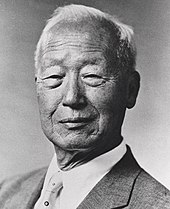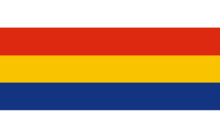User:Chasun
This article is incomplete because it is pending further input from participants, or it is a work-in-progress by one author. Please comment on this article's talk page to share your input, comments and questions. Note: To contribute to this article, you may need to seek help from the author(s) of this page. |
Republic of Chasun 차순공화국 (Chasunese) Jaseŏun Gonghwagug | |
|---|---|
| Capital and largest city | Geoju |
| Official languages | Chasunese |
| Recognised national languages | X Chasunese Sign Language (CSL) |
| Official script | Chasunese |
| Ethnic groups (2020) | 92.6% Chasunese 5.5% non-Chasunese Pamirans 1.9% other |
| Demonym(s) | Chasunese |
| Government | Unitary semi-presidential constitutional republic |
| Seo Ji-won | |
| Lyang Ho-seok | |
• Premier | Park Bong-hee |
| Yun Shyi-ho | |
| Moon Nam-kyum | |
| Legislature | National Diet |
| Establishment | |
• Byaheo Kingdom | c. 11th century AD |
| 1385 | |
| 14 March 1907 | |
| 6 November 1910 | |
| 29 July 1920 | |
| 7 September 1959 | |
• Admitted to the Assembly of Nations | 10 June 1961 |
| 15 April 1989–3 July 1989 | |
• Current constitution adopted | 23 December 1999 |
| Area | |
• Total | 244,141.4 km2 (94,263.5 sq mi) |
• Water (%) | 0.7% |
| Population | |
• 2019 estimate | |
• Density | 111.3/km2 (288.3/sq mi) |
| GDP (PPP) | 2019 estimate |
• Total | |
• Per capita | |
| GDP (nominal) | 2019 estimate |
• Total | |
• Per capita | |
| Gini (2017) | medium |
| HDI (2018) | very high |
| Currency | Chasunese juda (Ỻ) |
| Date format | YYYY/MM/DD |
| Driving side | right |
| Calling code | +60 |
| Internet TLD | .ch |
Chasun (Chasunese: 화국, Jaseŏn), officially the Republic of Chasun (ROC or RoC; Chasunese: 차순공화국, Jaseŏun Gonghwagug) is a country in Eastern Pamira, comprised of the Chasunese Peninsula and the central and western region of Seulhae. It is bordered to the north by X, to the east by the Iremic Ocean, to the south by X straddling the Chasun Sea, and to the west by X. Chasun is inhabited by approximately 27.2 million people in 2019, making it the tenth-most populous country in the world as well as one its most densely populated and urbanized countries. Its capital and largest city is Geoju on the Nai River, where a third of the country's population lives; other major cities of Chasun include Donghae, Jecheon, Yodang, Hyangchu, Ganchon and Deokwon.
The area of modern-day Chasun has been inhabited since the Lower Paleolithic period some 450,000 years ago, with the first known princerly states appearing in a X archived record in the late 6th century BCE. The princerly states of Seulhae eventually ceded their autonomy to the Byaheo dynasty originating from the Chasunese Peninsula in the late 11th century, becoming Chasun's first kingdom. Rule over modern-day Chasun alternated between the Byaheo (1055–1226), Haseong (1228–1382) and ultimately the Charasŏn dynasty (1383–1910), coinciding with or resulting from brief periods of foreign conquest and declining regional power known as the Horyueo period. The Charasŏn dynasty ultimately proved to be the most successful Chasunese empire under Emperor Wanjong, establishing contact with Berean traders and successfully resisting colonization in the early 19th century.
The economic decline of the Chasunese Empire in the late 1880s however led to the forced concession of much of the empire's territorial bulk to the Valimian Empire through the Treaty of Langiong and neighbouring states to the north and south, as well as the opening of multiple port cities to Berean trade with the Porcelain War (1888–1894) and Gul-yog Crisis (1896). In response, Chasun enacted a strict foreign policy of neutrality with the Gyeogli period. The collapse of the dynasty under Empress Sumyinjeong culminated in the Yeosin Rebellion of 1907, a short-lived scramble of Berean powers for influence and the establishment of the Kingdom of Chasun in 1910. It was subsequently overthrown by the military in the Summer Coup in 1920, and transformed into a de jure democratic, but authoritarian republic under nationalist Jeon Sang-cho.
In 1958, a Pamiran Federation-led invasion and Cuthish intervention in Chasun led to the Chasunese War and ended with the negotiated ceasefire of the Treaty of Samhan, dividing the country into the ROC and the Chasunese People's State as client states of the FCPR and Cuthland respectively. The collapse of the latter in 1989 due to economic stagnation and the explosive economic growth of the ROC in the 1980s known as the "Nai River Miracle" reunited a slowly reforming Chasun with the CPS, though with negotiated territorial concessions by X that approved of its reunification with the Acceptance Treaty. Societal and political pressure culminated into the 1989 April Struggle shortly after reunification, largely ending authoritarian rule and paving the way for a new constitution in 1999. Despite this, political freedoms and freedom of speech have repeatedly been violated by government action and Chasun persisted to remain an ally of Cuthland-Waldrich.
Today, Chasun is a developed country and with a gross domestic product of roughly US$725.7 billion, it is one of the largest economies in Pamira and the world by both nominal and PPP metrices. It consistently ranks well in other metrices such as education, public health and life expectancy, and the Human Development Index. 21st century Chasun witnessed a dramatic rise in the global popularity of its culture, particularly that of its cuisine, arts and pop culture, which has been referred to as the "C-Wave". Furthermore, it is generally considered to be a middle power and is a member of a variety of international organizations such as the Assembly of Nations, X, and maintains a partnership status with the Mageiros League.
Etymology
History
Antiquity and classical history
The Chasunese Peninsula is believed to have first been inhabited during the Lower Paleolithic by early hominids 2.1 million years ago. Archeological evidence consists of various stone, ivory and bone items, whereas sanded stone tools make up the majority. Other findings include wooden animal sculptures and depictions of wildlife carved in stone, as well as two complete fossil sets of Homo erectus called the "Sekung Women". Homo sapiens migrated to modern-day Chasun approximately 20,000 years ago. The arrival and intermingling of the Jamun people with the local population in 1,200 BC created the first civilization of Chasunese history, introducing wet-rice farming, metallurgy and pottery, as well as Chasunese proto-writing.
According to the classical Chasunese foundation legend, demigod Empress Ajehsane Dangguome founded the first kingdom, Horyeo, in 700 BC, of which the dynasties of all succeeding empires claim to be descendant of. However, the historical authenticity of said records remains disputed. The Noso period, believed to be Horyeo's golden age under semi-mythical Emperor Tiansong the Great in 660 BC, led to the formation of a uniform imperial court centered around Noso and the rise of a sophisticated culture of literacy and distinct identity. The mythical kingdom lasted for three century, before collapsing in 600 BC into smaller princerly states, namely Oseon, Chaijiho, Dangwon and Xihei, as recorded by X historians.
Feudal and dynastic era
Horyueo period (1225–1382)
Chasunese Empire (1383–1910)
After the Haseong dynasty had been overthrown by the Chanon armies under general Wu Haoh-beok in 1383, the Chanon occupied the imperial city of Tianseongong (present-day Geoju) and proclaimed the Chasunese Empire under the Charasŏn dynasty. By the 1390s, the dynasty had consolidated its power across the entire preceding empire and expanded into X through costly military campaigns. Under the Charasŏn, Chasunese culture flourished, with Emperors Guanyi and Janheol among other benevolent emperors of the late 1400s promoting the development of cultural artworks, scientific discoveries, a general dictionary and a standardized official script; however, nearly constant warfare made the Chasunese state nearly bankrupt and the highly developed state autocracy was reformed to crack down on political sentiment and restraining commerce, worsening the financial situation of the empire. Ultimately, this led to long-term economic and social stagnation throughout the 16th century.
During the latter 16th century, Chasun came into contact with Lavish traders and Semitar missionaries, initiating direct economic, political and cultural exchanges between Chasun and the western world, known as the Naraho period (1538–1597). Internal political strife at the imperial court of Emperor Gyeonggang was significantly worsened by the X invasion of Chasun between 1599 and 1608. The marshalled military under general Yi Kim-kol was able to repel the forces, and continue the now battle-hardened empire's peace which saw a significant, albeit short growth in wealth, thanks to a reformed tax system that filled the treasury. However, rising corruption in government and social unrest spawning righteous army militias shook Chasun with the onset of the Haebangsong Rebellion of the 1620s and the assassination of Emperor Hasogang in 1625.
The empire experienced continuous major societal tension after the 1620s, a result of multiple natural disasters such as the Great Flood of 1640 and Sihu Famine of 1669, as well as the increasing pressure from Berean powers, most notably Cuthland, to integrate Chasun's economy with the outside world. The ensuing Taihei Rebellion of 1604 in response to the erosion of imperial power in X and X cost the lives of some 5 million peasants and was ultimately ill-fated; Emperor Gihen adopted a number of court and administrative reforms, as well as early capitalist practices such as the introduction of futures contracts, insurance and Daekwon rice brokers banking, leading to economic rise in the 1700s.
The reign of Emperor Wanjong the Great (1791–1848) is considered to be the Charasŏn dynasty's golden age, successfully resisting more demanding Berean commercial interests and lifting restrictions on domestic trade and tariffs. After his death, the dynasty experienced Western imperialism in the form of the Porcelain War (1888–1894) against Mascylla, Falland and Cuthland, forced to pay substantial amounts of compensation, abandon its economic policy of protectionism, open port cities to Berean trade and grant Berean citizens extraterritoriality status. Furthermore, the Chasunese-Valimian War (1891–1894) exhausted its military and Chasun was forced to cede the territoral bulk of its north to the Valimian Empire with the Treaty of Liangong (1894).
Gyeogli period (1894–1920) and Kingdom
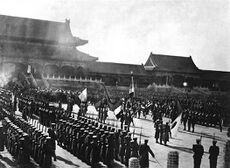
Following several military defeats and the pleas for foreign assistance in Chasun's frequent 19th century civil wars deeply humiliated the empire. Despite initial success in partly modernizing its industry and implementing a Western-styled constitution reorganizing the empire into a constitutional monarchy, Emperor Sonjong dramatically lost political power which lay in the public perception of its religiously enshrined position of superiority. The increasing inability by the government to exert control with its corruption-stricken modernized army led to civil unrest and a number of ethnic and religious insurgencies on the fringes of the empire such as the Bamoon Uprising of 1895, killing approximately 800 thousand civilians. The breakdown of political control over most of western Chasun led to the Gul-yog Crisis of 1896.
In 1905, Sumyinjeong was crowned Empress after Sojong passed away without any male heir; this further weakened the monarchy as staunchly conservative elements of the government openly opposed a female emperor. Political tension between the "Moderates" seeking to strengthen the constitutional monarchy, and the "Absolutists" seeking to overthrow the monarchy in favor of a republic, as well as the conservative factions of the military opposing Sumyinjeong and foreign intervention, culminated into the Yeosin Rebellion of 1907. Ultimately, the rebellion was crushed when a coalition army of Mascylla, Lavaria, Falland, Sarrac, Cuthland and Dulebia successfully intervened and occupied the capital of Tianseongong, now Geoju, aiding the initially defeated Chasunese monarchy. A captured Sumyingjeong was freed in March 1910 and relinquished her imperial title for Queen of the Kingdom of Chasun, a de jure independent successor to the empire but in reality a puppet state of the coalition's imperialist interests. With the outbreak of the Great War (1910–1916), Chasun became the battleground of opposed coalition troops, namely the Cuthish and Mascyllary in Donghae (1910) and Ganto (1911), putting the kingdom into disarray and undermining its legitimacy.
The power vacuum left behind by the removal of Armala Coalition troops from Chasun in 1916 was immediately filled by the Summer Coup of 1920, bringing an end to the Charasŏn dynasty. The First Republic of Chasun was established by general Jeon Sang-cho on 29 July 1920, and Empress Sumyinjeong presented the decree of abdication to the public on 1 August.
First Republic (1920–1958)
After the dissolution of the Kingdom of Chasun and the Chasunese imperial monarchy in 1920, the Republic of Chasun under president Jeon Sang-cho assumed governance. However, this rapid change politically fragmented the former empire. While the republican government centered around Geoju was internationally recognized and controlled the majority of the empire's military and treasury, it was de facto powerless in the face of warlords and family clans (former nobility) ruling most territories, and X declaring independence in 1921. Furthermore, the Republic was plagued by civil unrest and political instability surrounding its sphere of influence, most notably the collapse of the former imperial Wahon Armies in control of Yunai in 1926 amid internal fighting.
Intricate political and socio-economic manoeuvrings on the part of Jeon and his allies the Minjogjui (Nationalist Unity Party, NUP) and imperial field marshal Won Hae-ju with his faction allowed the republic to aggressively seize control over most of southern and eastern Chasun by the 1930s; nontheless, around two thirds of Chasun's then-territory remained lost. While Jeon Sang-cho and his close party affiliates implemented the Min-sa Reform to outline Chasun's future as a democratic republic in 1937, the military under Won Hae-ju backing Chasun's civil government pressured Jeon to hand over sweeping political influence and repress opponents, especially the Chasunese Communist Party (CCP) the Minjogjui hoped to cooperate with. With Jeon's death in 1939, the armed forces easily assumed power and Kim Nyeok-bin became president. Kim immediately purged the Minjogjui and his military from dissidents and possible rivals on 1 January 1940, consolidating his power overnight.
Civil strife occured in the form of the 1940 Protest Movement and the Bamaklan insurgency in southern Huewang (1941–53), however the Won military government responded with further suppressing political dissent. Cuthland emerged as a significant foreign ally of the new regime, providing Chasun with weaponry, difficult-to-access goods and international support, while Chasun in return offered strategic partnership and uranium ore for the Cuthish nuclear programme. Despite mutual economic aid, Chasun grew impoverished as its economy declined and government grew increasingly indebted to outside countries; this environment nurtured rising discontent and escalated into an outright uprising of the communist National People's Army (NPA), part of the outlawed CCP, against the republic beginning in 1953. During the insurgency, Kim proclaimed himself Emperor of Chasun with the support of pre-republic military officials on 15 September 1957, but he was met with harsh opposition from his own military, deposed and later killed in the 17 September coup d'état; this period significantly weakened the integrity of the republic and added to the NPA's initial success in swaying the Chasunese public against the military, leading to the Geoju Workers' Uprising of 1958. The new government under Chi Saem-il proclaimed the Second Republic of Chasun on 23 September.
Chasunese War and aftermath
The crisis in Chasun garnered the interest of the Great Game era international community, with the FCPR and Cuthland proclaiming the now Chasunese People's State and Republic of Chasun to be sovereign respectively. Seizing the opportunity to expand its control over eastern Pamira, the Pamiran Federation launched an invasion of Chasun in support of the CPS on 11 October 1958, while Cuthland scrambled to assist the Republic and more importantly safeguard its supply of Chasunese raw materials. The ensuing Chasunese War is considered to be the Great Game's first proxy war, and while swift on the side of the CPS at first, it quickly descended into stalemate. Ultimately, on 9 November 1959 both parties agreed to a temporary ceasefire and shortly after an armistice, known as the Chasunese Treaty of Armistice and Coexistence, was signed three days later; Chasun was split along a demilitarized zone between the CPS and ROC, though no real peace treaty was ever signed and both countries virtually remained at war.

In the aftermath of the war, neither government recognized the sovereignty of the other as part of the "One-Nation Doctrine", and both suffered from extensive destruction of their industrial bases. In the south, Chi Saem-il continued his presidency with the autocracy of his predecessors; aiming to cement his control after the war, Chi forced constitutional amendments in 1961 which exempted him from term limits and extended the country's state of martial law indefinitely. While that stabilized the country, the increasingly repressive economic policy hindered Chasun of developing economically throughout the 1960s. In the north, the CCP consolidated absolute political power over the CPS government, appointing Park Moon-lee as leader who pursued an idealistic economic reform policy ("Leap Into Modernity"), which however led to the starvation of more than 900,000 people between 1960 and 1970.

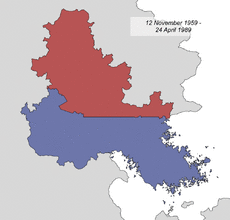
The employment of the military after accusations of the 1968 general elections being rigged by the ruling Minjogjui caused outrage among the public, and with itensifying political pressure Chi was ousted by his military during the 1 June 1968 coup d'état in order to regain control over Chasun. Once again, the presidency was assumed by a military general, Park Geon-sung, and the Third Republic of Chasun was proclaimed on 5 June 1968. To bolster public support for his new government, Park introduced sweeping new reforms that enabled large economic growth by exports known as the "Nai River Miracle", whereas the CPS witnessed a steep economic decline due to fatal mismanagement in the 1970s; additionally, the Chasunese population grew significantly from 14 million in 1970 to 23 million by 1985. The ROC and CPS formally recognized each other mutually and were admitted to the Assembly of Nations on 10 June 1971.
The autocratic military junta under Park persisted to rule the ROC until late 1989 wit the coinciding collapse of the CPS under Chak Tae-hil, which by that point was bankrupt and increasingly unable to control its protesting public during the Spring Students Revolution earlier in 1988. The resignation of Chak under mounting pressure on 31 December 1988 and the success of the revolution spilled over into the ROC, and students attempted to replicate the revolution in Geoju on 15 April 1989 against Park's regime who repeatedly promised democratic reforms. Negotiations of Chasunese reunification between both governments were exceptionally fast as the CPS government desintigrated, and Chasun was officially reunited on 24 April 1989. However, X demanded the territorial partition of the former CPS on the grounds of historic repatriation and denying the reigme the chance to expand its influence in central eastern Pamira. Though hostile at first, Park recognized X's military and political superiority and reluctantly gave in to sign the Acceptance Treaty on 5 June 1989. Meanwhile, country-wide protests and demonstrations shook the government and with the civil government denying Park his political powers, he fled into exile on 3 July. Acting Minister of State Raek Tan-woo announced the 4 July Declaration, calling for immediate general elections and the restoration of civil rights. A civil government under president Lee Dae-sam was elected by a landslide victory and a new constitution passed unanimously.
Contemporary history
Geography
Geography
Climate
Environment
Government and politics
Administrative divisions
| Map | Name | Chasunese script | Population (December 2019) |
|---|---|---|---|
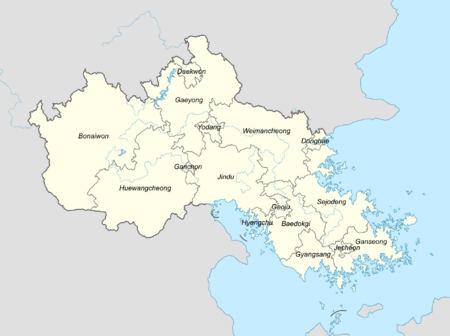 |
Special City Municipality (Teukbyeol-si-jachiche) | ||
| Geoju | 거주특별시자치체 | 5,726,004 | |
| Metropolitan Municipality (Gwangyeok-jachiche) | |||
| Donghae | 동해광역시자치체 | 2,153,570 | |
| Jecheon | 제천광역시자치체 | 1,841,108 | |
| Yodang | 요당광역시자치체 | 1,115,624 | |
| Daekwon | 대권광역시자치체 | 840,506 | |
| Hyangchu | 향추광역시자치체 | 661,837 | |
| Ganchon | 간촌광역시자치체 | 546,111 | |
| Region (Jiyeong) | |||
| Baedokgi | 배독기지역 | 4,280,692 | |
| Jindu | 진두지역 | 2,335,282 | |
| Sejodeng | 세조뎅지역 | 2,024,292 | |
| Weimancheong | 위만청지역 | 1,616,623 | |
| Gaeyong | 개용지역 | 1,246,190 | |
| Ganseong | 간성지역 | 911,382 | |
| Huewangcheong | 휴왕청지역 | 731,326 | |
| Gyangsang | 양상지역 | 579,439 | |
| Bonaiwon | 보나이원지역 | 564,004 | |






